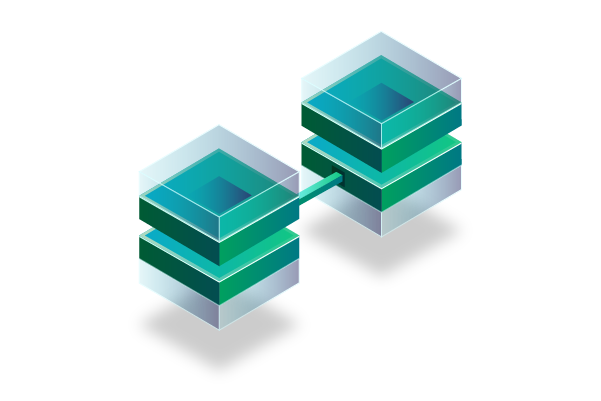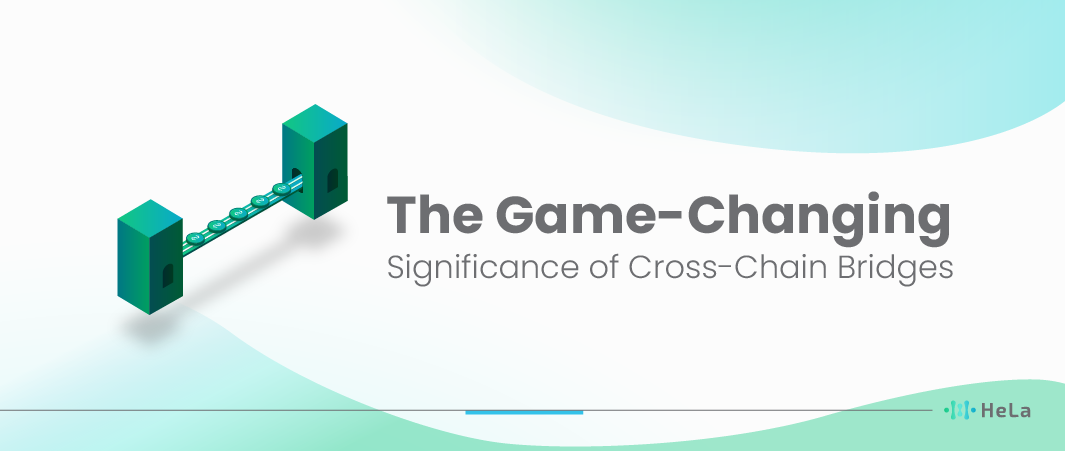In the ever-changing world of blockchain, there’s a growing need for smoother communication between different blockchains. Unlike regular systems that can usually connect using standard APIs, blockchains work differently, making integration a bit tricky. That’s where cross-chain bridges come in – they’re like the superheroes of blockchain interoperability. In this article, we’ll dive into what cross-chain bridges are, how they work, why they’re essential, and what role they play in our decentralized future.
Cross-chain bridges are essentially digital connectors that link one blockchain with another. Think of them as the bridges between islands in a vast digital ocean. They enable the transfer of assets and information across different blockchains, even if these blockchains use different technologies or have distinct rule sets. This ability to connect separate blockchains opens up a world of possibilities for decentralized applications, enabling them to interact seamlessly and share data and assets without friction.
Now, let’s talk about why cross-chain bridges are so vital. In a world where various blockchains power everything from cryptocurrencies to NFTs and decentralized finance, interoperability is key. Without these bridges, it’s like having isolated islands of data and value, making it challenging for users and developers to move assets between different blockchain ecosystems. Cross-chain bridges break down these barriers, making it easier for blockchain networks to communicate, collaborate, and, ultimately, create a more interconnected and efficient decentralized future.
What Are Cross-Chain Bridges?

Cross-chain bridges serve as a pathway between two or more blockchains, allowing assets and data to be transferred seamlessly. These bridges can be bi-directional, meaning assets can flow in either direction, or unidirectional, where assets can only move one way.
In simpler terms, imagine two cities separated by a river. Without bridges, the movement between these cities is limited, causing inefficiencies and limiting potential collaborations. Similarly, cross-chain bridges connect distinct blockchains, allowing assets to move freely, creating a more cohesive and functional blockchain ecosystem.
Also Read: Blockchain Adoption: Transforming Industries for a Digital Future
There are various mechanisms to facilitate this. Some utilize multi-signature wallets where validators confirm transactions, while others employ smart contracts to hold assets in escrow until conditions are met on the connected chains. The technical complexities vary, but the underlying principle remains the same: to connect disparate blockchains for enhanced utility and interoperability.
The Advantages of Cross-Chain Bridges

Cross-chain bridges have emerged as a critical component in the world of blockchain and cryptocurrency, providing a means to connect different blockchain networks. These bridges offer a range of advantages that have made them increasingly popular within the blockchain ecosystem. Here is a more detailed look at the advantages of cross-chain bridges:
Interoperability
One of the most significant advantages of cross-chain bridges is their ability to promote interoperability among various blockchain networks. Different blockchains often have their own unique features, consensus mechanisms, and smart contract languages. Cross-chain bridges enable these distinct ecosystems to communicate and share data, assets, or even execute transactions seamlessly. This interoperability opens up new possibilities for cross-platform applications and services.
Asset Liquidity
Cross-chain bridges facilitate the transfer of assets, such as cryptocurrencies or tokens, between different blockchains. This enables users to move their assets between networks to take advantage of various DeFi protocols, yield farming opportunities, or simply to diversify their holdings. Increased liquidity across chains can also reduce price volatility for assets, making them more stable and attractive for investors.
Scalability
Achieving scalability poses a significant hurdle for numerous blockchain networks. Cross-chain bridges can help alleviate this issue by allowing transactions and smart contract executions to be distributed across multiple blockchains. This can help reduce congestion and increase the overall throughput of blockchain networks, ultimately improving their scalability.
Risk Mitigation
Cross-chain bridges can be used as a risk mitigation strategy. If one blockchain network experiences technical issues, vulnerabilities, or regulatory challenges, users can quickly move their assets to a different, more stable chain through these bridges. This flexibility can help protect users from potential losses.
Enhanced Security
Some cross-chain bridges are designed with security features to prevent attacks and fraud. By leveraging multiple blockchains, these bridges can add an extra layer of security to asset transfers and smart contract interactions. Additionally, the transparency and immutability of blockchain technology can help in auditing and verifying the integrity of cross-chain transactions.
Global Accessibility
Cross-chain bridges enable users from different parts of the world to access various blockchain networks, including those with different use cases and governance models. This promotes inclusivity and expands the reach of blockchain technology to a wider audience, potentially increasing adoption.
Cross-Platform Applications
Developers can create cross-platform applications that utilize the unique features of multiple blockchains. For example, a developer could build a DeFi application that utilizes stablecoins from one blockchain, decentralized lending protocols from another, and liquidity pools from yet another blockchain. This allows for innovation and the creation of novel solutions.
Market Efficiency
Cross-chain bridges can improve market efficiency by reducing the fragmentation of assets across different blockchains. This can lead to more efficient price discovery and trading, as well as a reduction in arbitrage opportunities between different blockchain-based markets.
Cross-chain bridges play a crucial role in the evolving blockchain landscape by promoting interoperability, liquidity, scalability, security, and global accessibility. These advantages make them a fundamental building block for the development of a more connected and efficient blockchain ecosystem.
Real-World Applications of Cross-Chain Bridges

Cross-chain bridges play a crucial role in the world of blockchain and cryptocurrency by enabling interoperability and communication between different blockchain networks. These bridges serve as connectors that facilitate the transfer of digital assets and data across otherwise isolated or distinct blockchain ecosystems. Here are some real-world applications and contexts where cross-chain bridges are becoming increasingly important:
Decentralized Finance (DeFi)
DeFi has been one of the most prominent use cases for cross-chain bridges. DeFi projects often operate on different blockchain platforms, and cross-chain bridges enable the movement of assets like stablecoins, tokens, and liquidity between these platforms. Users can access a broader range of financial services and opportunities while retaining control over their assets.
Asset Tokenization
Cross-chain bridges are used to tokenize real-world assets such as real estate, art, or commodities. These tokens can then be traded on various blockchain networks, expanding liquidity and accessibility. For example, a piece of real estate can be tokenized on one blockchain and traded on another through a cross-chain bridge.
Cross-Border Payments
Cross-chain bridges can be applied to cross-border payments, simplifying and accelerating the process. Users can transfer value from one blockchain to another, making it easier to send money internationally without relying on traditional financial intermediaries.
NFT Ecosystem
Non-fungible tokens (NFTs) represent unique digital assets that can be created and traded on different blockchains. Cross-chain bridges enable NFTs to move between different ecosystems, increasing their utility and reach. This is particularly useful for artists, creators, and collectors who want to access a broader market.
Scalability and Network Upgrades
Blockchain networks often undergo upgrades and face scalability challenges. Cross-chain bridges allow for the movement of assets and data from an older, congested, or less efficient network to a newer, more scalable one. This can help alleviate network congestion and improve user experience.
Privacy and Security
Different blockchains offer varying levels of privacy and security. Users may want to move assets or data between chains with different security and privacy features. Cross-chain bridges can facilitate these transfers while maintaining the desired level of security and privacy.
Supply Chain Management
Cross-chain bridges can be used to link different blockchain-based supply chain management systems. This can enhance transparency, traceability, and trust throughout the supply chain, making it easier to verify the authenticity and origin of products.
Token Swaps and Exchanges
Cross-chain bridges enable decentralized token swaps and exchanges. Users can trade tokens from different blockchains without relying on centralized exchanges, reducing counterparty risk and enhancing decentralization.
Cross-Platform Gaming
In the world of blockchain gaming, cross-chain bridges allow gamers to move in-game assets and characters across different gaming ecosystems. This interoperability can enhance the gaming experience and create new opportunities for players.
Blockchain Interoperability
In general, cross-chain bridges contribute to the broader goal of blockchain interoperability. This fosters collaboration and synergy between different blockchain communities, driving innovation and expanding the possibilities of decentralized technology.
Potential Challenges and C onsiderations
While cross-chain bridges usher in a realm of possibilities, they’re not without challenges that need careful consideration:
Security Concerns
One of the foremost challenges is the security of assets transferred across different blockchains. Ensuring the integrity and confidentiality of data during the bridging process is paramount, as any vulnerability could lead to theft or manipulation.
Interoperability Issues
Different blockchains often have their own unique architectures, consensus mechanisms, and smart contract languages. Bridging between them requires seamless interoperability, which can be technically complex to achieve.
Consensus Divergence
Blockchains may have different consensus algorithms, leading to varying confirmation times and finality. Bridging assets between chains with different consensus mechanisms can introduce delays and complexities in transaction confirmation.
Oracles and Trust
Many cross-chain solutions rely on oracles to facilitate communication between chains. The trustworthiness and reliability of these oracles are crucial, as they can become single points of failure or manipulation.
Regulatory Compliance
Navigating regulatory frameworks across multiple jurisdictions can be challenging. Compliance with different regulations regarding cross-border transactions and the transfer of assets is essential for legality and sustainability.
Scalability
As more and more people start using cross-chain bridges, one of the main worries that pops up is scalability. Think of it like this: when lots of people are trying to move things between different blockchains, it’s a bit like a busy highway during rush hour. All that traffic can put a heavy load on the blockchains, causing them to slow down or even get jammed up. When this happens, it can lead to congestion and make the fees for using these services go up. So, making sure these bridges can handle the growing popularity is a big concern.
User Experience
To make cross-chain solutions more appealing to users, it’s crucial to ensure that the bridging process is straightforward and user-friendly. When things get too complicated, waiting times become lengthy, or fees are too high, it can discourage people from getting involved with these solutions. Simplifying the process, reducing wait times, and keeping fees reasonable can encourage more users to embrace cross-chain technology.
Smart Contract Risks
Smart contracts can pose risks when they’re used on different blockchains. It’s really important to make sure these contracts are secure and can work smoothly on various chains. This means checking for vulnerabilities and making sure they play nicely with different blockchain systems.
Token Standards
Various blockchains employ distinct token standards such as ERC-20, BEP-2, and NEP-5, which can make transferring and managing assets a bit tricky. Bridging solutions need to be adaptable to these diverse standards, essentially acting like translators to ensure seamless asset movement across different blockchains. This way, you can think of it as a universal bridge that makes sure your digital assets can travel smoothly, regardless of the blockchain they originate from.
Audit and Verification
Regularly conducting audits and code reviews for cross-chain bridge protocols is crucial to spot potential weaknesses and guarantee the reliability of the bridge’s operations. These checks involve experts thoroughly examining the code and its functions to identify any potential security issues or bugs that could jeopardize the safe transfer of assets between different blockchains. By doing so, we can maintain trust in the bridging process and ensure that users’ assets remain secure when moving from one blockchain to another, providing a seamless and reliable experience for everyone involved.
Economic Incentives
In cross-chain systems, it’s crucial to make sure that both the folks who help validate transactions (validators) and the people who use the system (users) have good reasons to play nice. This means that the rewards and benefits they get should be set up in a way that encourages everyone to keep things safe and working smoothly. If validators and users feel like they’re getting a fair deal and their interests are in sync, the system is more likely to stay secure and operate well. So, it’s all about finding the right balance in what each group gets from being a part of the cross-chain network to make sure everything runs smoothly.
Long-Term Viability
The rapidly evolving blockchain landscape means that a solution considered state-of-the-art today may become obsolete or incompatible in the future. Long-term planning and adaptability are critical.
Community and Ecosystem Support
Building a thriving ecosystem around cross-chain bridges is crucial for their success. Gaining support from developers, projects, and the broader blockchain community is a challenge that must be met.
Fallback Mechanisms
In case a bridge encounters a problem or something unexpected happens, it’s really important to have good backup plans and safety measures in case things go wrong. These backup plans help to reduce any potential losses that could occur. So, having a solid backup strategy is like having a safety net to catch us if something goes awry with the bridge. It’s kind of like having a spare tire in your car – you hope you never need it, but it’s reassuring to know it’s there just in case.
Complexity
Connecting two distinct environments can bring about technical challenges that might result in unexpected problems. When you try to link two different systems or ecosystems, like making your smartphone work seamlessly with your smart home devices, you could run into all sorts of tricky situations. These could range from compatibility issues to glitches that pop up out of the blue, causing headaches for users. So, it’s important to be prepared for the potential hiccups that can arise when merging these two worlds to ensure a smoother experience for everyone involved.
Finality
The time it takes for blocks to be considered final on different blockchain networks can cause delays or even the risk of someone spending the same cryptocurrency twice. Imagine it like this: when you send a digital coin, you want to be sure it’s gone from your account, right? Well, if one blockchain takes a long time to make absolutely sure a transaction is permanent while another one does it faster, you might have to wait longer in the slower system. Worse yet, in the faster system, someone could try to spend the same coin again before it’s fully settled, leading to potential problems. So, how quickly a blockchain makes things final can affect how smoothly transactions work.
Also Read: What is Web3? A Journey into Decentralization
Trust
In the world of bridges and blockchain technology, most want to spread out the power and control, but in certain cases, folks might need to rely on middlemen or validators. These are like the referees of the system, making sure everything runs smoothly and people play fair. So, while decentralization is the goal for many, sometimes you’ve got to put your trust in these folks to keep things in check and prevent any funny business.
Addressing these challenges and considerations is vital to realizing the full potential of cross-chain bridges while ensuring the security, reliability, and usability of these innovative solutions.
Conclusion
Cross-chain bridges, though relatively nascent, have already shown their pivotal role in the blockchain ecosystem’s expansion. They hold the promise of a truly interconnected blockchain world, where assets and data flow freely across different networks. By understanding their mechanisms, benefits, and potential challenges, one can appreciate the profound impact they could have on our decentralized future.
However, as with all technological advancements, due diligence and continuous research are essential. As the industry matures, it’s expected that the challenges will be addressed, paving the way for a more integrated and efficient decentralized world.
In the end, cross-chain bridges are more than just technical marvels. They’re a testament to the blockchain community’s relentless drive to innovate, integrate, and push the boundaries of what’s possible in the realm of decentralized technology.
Disclaimer: The information provided by HeLa Labs in this article is intended for general informational purposes and does not reflect the company’s opinion. It is not intended as investment advice or recommendations. Readers are strongly advised to conduct their own thorough research and consult with a qualified financial advisor before making any financial decisions.

Joshua Soriano
I am a writer specializing in decentralized systems, digital assets, and Web3 innovation. I develop research-driven explainers, case studies, and thought leadership that connect blockchain infrastructure, smart contract design, and tokenization models to real-world outcomes.
My work focuses on translating complex technical concepts into clear, actionable narratives for builders, businesses, and investors, highlighting transparency, security, and operational efficiency. Each piece blends primary-source research, protocol documentation, and practitioner insights to surface what matters for adoption and risk reduction, helping teams make informed decisions with precise, accessible content.
- Joshua Soriano#molongui-disabled-link
- Joshua Soriano#molongui-disabled-link
- Joshua Soriano#molongui-disabled-link
- Joshua Soriano#molongui-disabled-link

